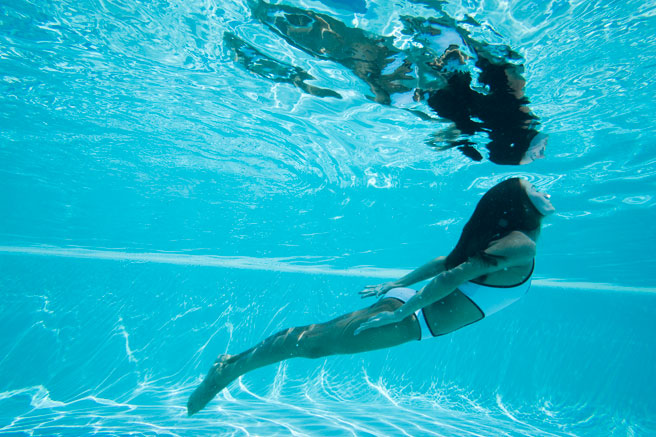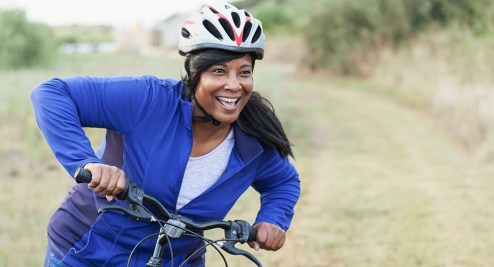Water workouts
If you want to get fit fast and switch off from everyday stress, dive in to your local pool for a water workout, says Anastasia Stephens

Water is, of course, beautifully refreshing, but it’s the fact that it provides more resistance than air that means it’s the perfect place to get fit. With the help of water, say experts, we can work our heart, tone muscles and build strength faster and more effectively than on dry land. And because we become virtually weightless, we give our joints a rest, vastly reducing any risk of injury.
‘Elite sportspeople, especially top runners, go running in water when they’ve been injured — it helps them regain strength while protecting their joints,’ says physiotherapist and fitness coach Jason Henry. ‘It’s also beneficial for people with arthritis. In a weightless environment joints are supported and they have a greater range of motion.’
Working out in water can benefit everyone. Research by Dr Robert Wilder, director of sports rehabilitation at the University of Virginia, has found that water-based exercise burns about 30 per cent more calories than the equivalent exercise on land.
And because water offers 12 times more resistance than air, muscles are given a workout from every angle — resulting in greater muscle definition and all-round strength.
Then there’s the buoyancy factor. Research at the University of Virginia found that if you work out in water up to neck level, your body weight is effectively reduced by as much as 90 per cent. A 9st 4lb woman working out neck deep in water would weigh less than a stone, putting much less strain on her body.
Psychologically, exercising in water is both soothing and relaxing. ‘In water, your movements are naturally slower and that helps people slow down,’ says aqua jogging teacher Pamela Jameson. ‘People tend to switch off quickly from everyday stresses, especially with less vigorous water workouts such as aqua yoga.’ So if you’re tempted to dip your toe in the water, which type of workout is right for you?
Aqua aerobics
What is it? You go through an aerobics routine in the pool using floats as props. Some classes use under water steps with suckers to secure them to the bottom of the pool.
Benefits: ‘A range of movements means you work your muscles from all angles against the water’s resistance,’ says Henry. ‘This is a good all-round cardiovascular and muscle-toning workout.’
Good for: Boosting circulation and all-round fitness. Aqua aerobics classes are held at leisure centres nationwide.
Aqua jogging
What is it? Wearing a buoyancy belt, you start running in shallower water, aiming to end up in water that reaches your neck. The belt helps to keep you upright as you run on the spot supported by the water.
Benefits: ‘In water, pressure-bearing joints such as the hip and knees, which are impacted on land, are relieved,’ says Jameson. Aqua jogging strengthens the leg and hip muscles and boosts heart rate.
Good for: Regaining strength after an injury. Physiotherapists recommend it for back problems. For information about aqua jogging classes, go to virginactive.co.uk.
Aqua yoga
What is it? A series of yogic poses are performed in waist-deep water. The support the water gives you can add flexibility and mobility to weaker joints, allowing you to do stretches that you couldn’t do on land.
Benefits: ‘Gentle and low impact, aqua yoga enhances flexibility and range of motion while the risk of any overstretching or joint injury is greatly reduced,’ says Dr Rowena Nicholson, aqua yoga teacher.
Good for: pregnant women who want to improve flexibility before birth, as it relieves pressure on the abdomen. With no stress being exerted on joints, aqua yoga is also good for people with arthritis. Aqua yoga is available at leisure centres nationwide.
Poolates
What is it? Like pilates, poolates focuses on strengthening core postural muscles with a series of exercises based on small movements that work deep muscles along the abdomen and spine. Long, thin tubes of foam are used in some exercises as props.
Benefits: According to poolates instructor Michelle Martin, your stomach and lower back muscles are challenged constantly by the motion of the water. As a result, core muscles can be strengthened faster and more effectively than with land-based exercise.
Good for: improving posture and core strength, and for people who suffer with back pain. For information on poolates and classes, go to poolates.co.uk or passion4pilates.co.uk.
Aqua combat
What is it? Standing chest high in water, you perform a series of underwater karate and kickboxing moves such as strikes, kicks and punches.
Benefits: Normally, when you hit a punchbag a shock wave will be sent down your arm. But when punching under water, you have to work hard just to push your arm and there’s no impact at the other end. ‘What you get is a strong resistance-based workout that strengthens your stomach, core muscles, arms and legs,’ says Henry.
Good for: building up muscles called stabilisers, which strengthen the back, improve balance and help flatten the stomach. Aqua combat classes are held at Total Fitness health clubs nationwide.
Watsu
What is it? Developed in California in 1980, Watsu combines the benefits of a shiatsu massage with the relaxing effects of weightlessness in water. Trained practitioners guide your body, and sessions include gentle stretches in tune with your natural breathing pattern, coupled with moments of stillness.
Benefits: ‘The warmth and weightlessness of the water and the gentle movements mean that clients can let go and enjoy a state of deep relaxation,’ says Watsu teacher Dawn Watts. Meanwhile, the pressure of the water gently tones the muscles.
Good for: stress and related problems, such as disrupted sleep patterns and low immunity. For further information on Watsu, go to watsu.co.uk.








